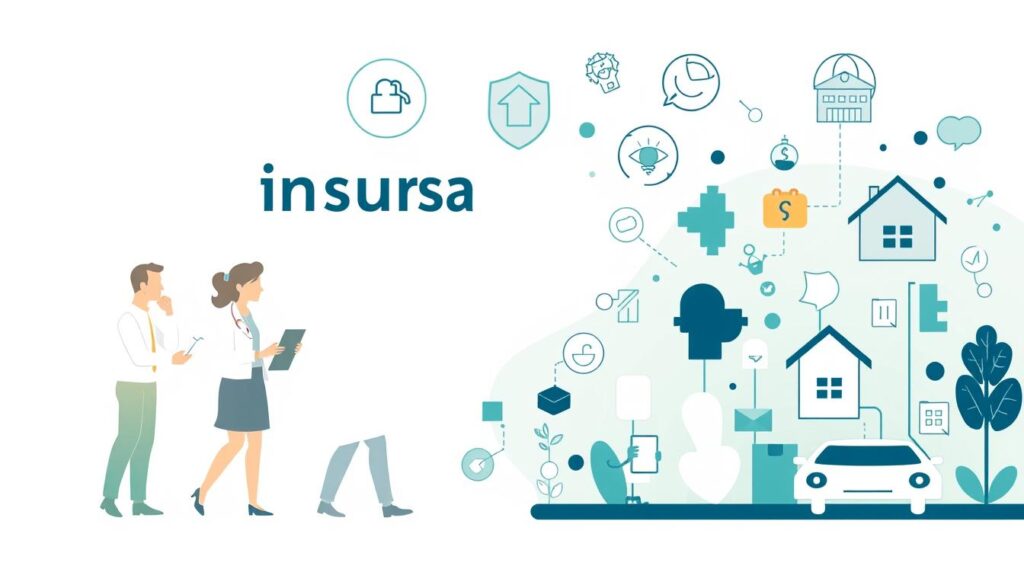The stability that insurers have long relied on is disappearing. In just the past three years, the world has faced a pandemic, violent political unrest, severe supply chain disruptions, global conflict, high inflation, and extreme weather events. This succession of crises has transformed the insurance industry landscape.
We’re witnessing an unprecedented transformation in how insurance is designed, sold, and serviced. At CoWrit Technologies Inc, specialists in AI generative applications and digital transformation, we’ve observed how technology is reshaping the industry. As the world becomes increasingly unpredictable, embracing technological innovation is no longer optional but essential for survival and growth.
Cutting-edge technologies are fundamentally altering insurance business models, creating new opportunities for forward-thinking companies. From AI revolutionizing underwriting to blockchain transforming claims processing, key trends are defining the future of insurance technology.
Key Takeaways
- The insurance industry is at a critical inflection point due to global crises and technological advancements.
- Technological innovation is crucial for insurers’ survival and growth.
- AI and blockchain are among the key technologies transforming the insurance sector.
- Forward-thinking insurance companies are embracing these changes to stay ahead.
- The future of insurance technology is being shaped by cutting-edge trends.
The Evolving Landscape of Insurance Technology
With technological innovation accelerating at an unprecedented rate, the insurance industry is being reshaped in profound ways. We’re witnessing a fundamental shift in how insurance companies operate, driven by the need to adapt to changing customer expectations, regulatory requirements, and risk landscapes.
Current State of the Insurance Industry
The insurance sector is characterized by increasing competition, evolving regulatory requirements, and the need to navigate complex risk landscapes across all insurance sectors. Legacy systems and traditional operational models are struggling to keep pace with the digital transformation happening across the financial services sector.
- The current landscape is marked by a growing need for insurers to be agile and responsive to changing market conditions.
- Insurers must balance the need for innovation with the requirement to maintain robust risk management practices.
This environment is creating both challenges and opportunities for insurers, as they seek to leverage technology to enhance their operations and improve customer outcomes.
Key Drivers of Technological Change
Several key factors are driving technological change in the insurance industry. These include the increasing availability of data, advancements in analytical capabilities, and changing customer expectations.
- The STEEP factors (social, technological, economic, environmental, and political) are creating a fractured world where insurers must cover a greater array and frequency of intensifying risks.
- Market reconfiguration is occurring as digital channels and wider distribution points via partnerships and embedded options are disintermediating markets, challenging established carrier primacy.
As we move forward, it’s clear that change will be a constant in the insurance landscape, driven by the ongoing interplay between technological innovation and evolving customer needs.
The Future of Insurance Technology: A Paradigm Shift
The future of insurance is being shaped by technology, leading to a paradigm shift in how insurers operate and interact with customers. This transformation is not just about adopting new tools; it’s about fundamentally changing the insurance value chain. As technology continues to advance, we’re seeing a shift from the traditional “detect and repair” model to a more proactive “predict and prevent” approach.
From “Detect and Repair” to “Predict and Prevent”
The insurance industry is undergoing a significant transformation as it moves from a “detect and repair” model to a “predict and prevent” one. This change is driven by technological advancements that enable insurers to anticipate and mitigate risks before they result in losses. Predictive analytics and machine learning are at the forefront of this shift, allowing for more accurate risk assessment and personalized insurance offerings.
We’re witnessing a fundamental change in the nature of insurance, with technology enabling insurers to help customers avoid losses altogether. This not only improves customer satisfaction but also reduces the financial burden on insurers. The future of insurance technology will be characterized by increasingly personalized offerings, dynamic pricing models, and real-time risk assessment capabilities.
Technology as a Competitive Differentiator
In the insurance marketplace, technology is rapidly becoming the primary competitive differentiator. Companies that successfully leverage advanced technologies are gaining significant advantages in customer acquisition, retention, and profitability. Forward-thinking insurers are investing heavily in technological capabilities, not just to improve operational efficiency but to create entirely new business models and revenue streams.
As all stakeholders in the insurance ecosystem become more adept at using advanced technologies, the pace of change is accelerating. This includes enhancements in decision-making, productivity, cost reduction, and customer experience optimization. The table below summarizes the key differences between the current and future states of insurance technology.
| Aspect | Current State | Future State |
|---|---|---|
| Approach | Detect and Repair | Predict and Prevent |
| Risk Assessment | Retrospective | Real-time and Predictive |
| Customer Interaction | Transactional | Personalized and Proactive |
As we move forward, it’s clear that the insurance industry will continue to evolve, driven by technological innovation. The paradigm shift towards “predict and prevent” is not just a change in approach; it’s a fundamental transformation of the insurance value chain.

Artificial Intelligence Revolutionizing Insurance

With the advent of deep learning techniques, AI is poised to revolutionize the insurance industry. We’re seeing artificial intelligence fundamentally change insurance operations across the entire value chain, from customer acquisition to claims processing.
The disruption caused by COVID-19 has significantly accelerated the digitization of insurers, pushing the adoption of AI technologies to the forefront. As a result, AI is transitioning from experimental applications to core operational technologies that are changing how insurance companies make decisions and serve customers.
AI-Powered Underwriting and Risk Assessment
AI is enabling insurers to analyze vast amounts of structured and unstructured data to develop more accurate risk profiles and pricing models than ever before possible. Deep learning techniques, such as convolutional neural networks, are allowing AI systems to mimic human perception, reasoning, and problem-solving capabilities in increasingly sophisticated ways.
At CoWrit Technologies, we’re helping insurance companies implement AI solutions that enhance operational efficiency while maintaining the human touch that customers still value. This integration of AI in underwriting and risk assessment is a significant step forward in the insurance industry, leveraging technology to improve outcomes.
Fraud Detection and Claims Processing
AI-powered fraud detection systems are transforming claims processing by identifying patterns and anomalies that human analysts might miss, significantly reducing fraudulent payouts. This not only saves insurers money but also improves customer satisfaction by streamlining the claims process.
The use of AI in insurance is revolutionizing the way companies detect fraud and process claims, making the entire process more efficient and reliable. As we continue to innovate and integrate AI into various aspects of the insurance industry, we are witnessing a significant shift towards a more technologically advanced and customer-centric model.
Customer-Centric Digital Transformation
As the insurance industry continues to evolve, we’re seeing a significant shift towards customer-centric digital transformation. This change is driven by the need to adapt to changing customer expectations, technological advancements, and market dynamics. Insurers are embracing advanced technologies to enhance accessibility and collaboration, aiming to improve the customer experience and streamline operations.
To achieve this, insurers are transforming from product-centric to customer-centric organizations. This fundamental shift places customer needs and experiences at the heart of their business models.
“The future of insurance is about creating personalized experiences that meet customers where they are.”
Personalized Customer Experiences
Digital transformation in insurance is enabling personalized customer experiences through data analytics, AI-driven insights, and omnichannel engagement strategies. The personalization of insurance offerings is moving beyond simple demographic segmentation to behavior-based, contextual, and predictive personalization that anticipates customer needs.

Digital-First Approach to Insurance
A digital-first approach to insurance is becoming the industry standard, with companies redesigning their processes, products, and services around digital capabilities and customer expectations. This transformation requires not just technological changes but cultural shifts within insurance organizations to become more agile, innovative, and responsive to rapidly evolving customer needs.
By adopting a digital-first approach, insurers can enhance customer experiences while improving operational efficiency and creating new revenue opportunities. We’re helping insurance companies implement digital transformation strategies that put the customer at the forefront, leveraging technology to drive business success.
Self-Service Platforms for Policyholders

The growing demand for digital autonomy is driving insurance providers to adopt self-service platforms that empower policyholders to manage their insurance needs independently. This shift is significantly shaping policyholder experiences in 2024, driven by the growing demand for digital solutions that allow customers to manage their insurance policies with greater autonomy and convenience.
As insurers continue to evolve, the number of people willing to switch insurance providers due to the lack of a user-friendly customer portal has increased dramatically, indicating a clear preference for digital platforms. A vast majority of insurers now offer policy management capabilities via mobile apps, with custom insurance applications becoming the preferred channel for customer servicing.
Essential Features of Modern Self-Service Portals
Modern self-service portals are becoming essential competitive tools for insurers. Essential features of effective self-service platforms include:
- Intuitive user interfaces that simplify navigation and policy management.
- Automated workflows that streamline processes and reduce manual errors.
- Personalized dashboards that provide a tailored experience for each customer.
- Electronic signature capabilities that facilitate quick and secure document signing.
- Integrated knowledge bases that offer valuable information and support.
Benefits of Customer Autonomy
The benefits of customer autonomy extend beyond convenience to include increased transparency, greater control over insurance decisions, and more frequent positive interactions with insurance providers. By empowering customers, insurers can enhance satisfaction and loyalty.
Self-service platforms are evolving from simple policy management tools to comprehensive insurance management ecosystems that support customers throughout their insurance journey. We’re helping insurance companies develop and implement self-service platforms that balance automation with personalized support to create seamless customer experiences.
Custom Insurance Apps and Customer Portals

The adoption of custom insurance apps and customer portals is on the rise among insurance companies. This shift is driven by a significant increase in the number of people willing to switch insurance providers due to a lack of user-friendly customer portals.
User-Friendly Interfaces and Accessibility
User-friendly interfaces and accessibility are no longer optional features but essential components that determine whether customers stay with or switch from their current insurance providers. The most effective insurance apps and portals are designed with accessibility in mind, ensuring they work seamlessly across devices and accommodate users with varying levels of technical proficiency and abilities.
Automated Workflows and Personalization
Automated workflows are transforming how customers interact with their insurance policies, enabling self-service for everything from policy changes to claims submission with minimal friction. Personalization capabilities are becoming increasingly sophisticated, with customer apps and portals adapting to individual user preferences, behaviors, and needs to create tailored experiences.
At CoWrit Technologies, we’re helping insurance companies develop custom digital solutions that balance technological innovation with human-centered design principles to create exceptional customer experiences. By leveraging customer data and preferences, insurers can create more engaging and relevant interactions, ultimately driving customer satisfaction and loyalty.
Omnichannel Customer Experiences
In the current digital landscape, insurers are increasingly adopting omnichannel approaches to enhance customer experiences across various touchpoints. This strategy involves creating consistent and integrated experiences across multiple communication channels, including online platforms, phone calls, and in-person interactions.
Seamless Integration Across Channels
Seamless integration across communication channels is becoming a competitive necessity in the insurance industry. It allows customers to start an interaction in one channel and continue it in another without friction or repetition. For instance, a customer might initiate a claim online and then follow up with a phone call for more detailed discussions. Insurers who successfully integrate their channels can significantly enhance customer satisfaction and loyalty.
We’re seeing insurance companies adopt omnichannel strategies that create seamless, consistent experiences across all customer touchpoints. The most successful approaches recognize that different customer segments have different channel preferences and optimize each channel accordingly while maintaining consistency.

Balancing Innovation with Human Touch
While digital innovation is crucial, balancing it with a human touch remains a critical challenge. Even the most digitally savvy customers sometimes need or prefer human interaction for complex insurance matters. Insurers must leverage technology to enhance, rather than replace, human connections and create more meaningful customer relationships.
The future of insurance service lies in creating intelligent omnichannel experiences that adapt to customer preferences and needs in real-time. This involves providing the right level of support through the right channel at the right time. By doing so, insurers can not only improve customer engagement but also foster loyalty in a highly competitive market.
| Channel | Customer Preference | Insurer’s Response |
|---|---|---|
| Online | Self-service, quick queries | Intuitive portals, chatbots |
| Phone | Complex issues, personal touch | Trained representatives, callback options |
| In-person | Complex claims, personalized advice | Local offices, face-to-face meetings |
Internet of Things (IoT) and Connected Devices

The integration of IoT and connected devices is redefining risk assessment and management in insurance. We’re witnessing a revolution in insurance as IoT and connected devices transform how risk is assessed, priced, and managed across all insurance lines.
Real-Time Data Collection and Risk Assessment
Real-time data collection from connected devices is enabling insurers to move from static, demographic-based risk assessment to dynamic, behavior-based models that more accurately reflect actual risk. IoT devices, such as telematics in vehicles and smart home sensors, provide real-time data that insurers use for dynamic risk assessments and premium adjustments.
This technology leads to more personalized insurance plans and encourages safer behaviors among policyholders. For instance, smart home devices can detect potential risks before they cause damage, allowing for proactive measures.
Telematics and Usage-Based Insurance Models
Telematics is fundamentally changing auto insurance by enabling usage-based models that price coverage based on actual driving behavior rather than proxy variables like age or credit score. The preventive capabilities of IoT devices are shifting the insurance paradigm from compensation after loss to prevention of loss.
- Smart home devices, wearables, industrial sensors, and connected vehicles are creating vast new data streams that insurers can leverage to develop more personalized and precise insurance offerings.
- We’re helping insurance companies develop strategies to effectively collect, analyze, and act on IoT data while addressing privacy concerns and creating value for both insurers and customers.
Blockchain Technology in Insurance

As we explore the future of insurance, blockchain technology emerges as a key player. We’re seeing blockchain transform the insurance landscape by enhancing transparency, security, and efficiency.
The integration of blockchain in insurance is gaining momentum, promising to redefine industry standards. Smart contracts are at the forefront of this change, automating claims processing and underwriting by executing predefined actions when specific conditions are met.
Automating Claims with Smart Contracts
Smart contracts are revolutionizing the way insurance claims are processed. By automating the execution of insurance agreements based on predefined conditions, they significantly reduce processing times and increase transparency.
This automation not only enhances the customer experience but also reduces the need for intermediaries, thereby lowering costs.
Enhanced Security and Transparency
The immutable nature of blockchain technology creates unprecedented transparency in insurance transactions. All parties can access a single version of truth regarding policy terms, claims history, and payment records.
Moreover, the distributed ledger technology significantly reduces the risk of fraud and unauthorized data manipulation, enhancing trust between insurers and policyholders.
We’re helping insurance companies navigate the technical and regulatory complexities of blockchain implementation to address specific business challenges.
Predictive Analytics and Machine Learning

As we move forward, the role of predictive analytics and machine learning in insurance is becoming increasingly pivotal. These technologies are revolutionizing the industry by enabling insurers to make data-driven decisions, optimize pricing, and streamline claims management.
The insurance industry is witnessing a significant shift towards data-driven decision making across all functions, from marketing and distribution to underwriting, pricing, claims, and customer service.
Data-Driven Decision Making
Advanced algorithms are enabling insurers to analyze vast and diverse datasets to identify patterns and correlations that would be impossible for human analysts to detect. We’re seeing predictive analytics and machine learning transform insurance from an industry based on historical data analysis to one that can accurately forecast future outcomes and behaviors.
Customized Risk Profiles and Dynamic Pricing
Customized risk profiles are replacing broad risk categories, allowing insurers to assess each customer’s risk with unprecedented precision and tailor coverage and pricing accordingly.
Dynamic pricing models that adjust in real-time based on changing risk factors are becoming increasingly common, creating more accurate and fair pricing structures. By leveraging predictive analytics and machine learning, insurers can provide more personalized services, enhancing customer satisfaction and loyalty.
Evolution of Insurance Distribution Models
We’re witnessing a paradigm shift in how insurance products are being sold and distributed. The traditional agent-based models are being supplemented and sometimes replaced by digital channels and embedded insurance. This transformation is driven by technological advancements, changing consumer behaviors, and the need for more efficient and personalized insurance experiences.
The Changing Role of Insurance Agents
The role of insurance agents is evolving significantly. By 2030, the number of agents is expected to decrease substantially as many retire, and the remaining agents will rely heavily on technology to enhance their productivity. Agents are transitioning from being mere transaction processors to trusted advisors who help customers navigate complex insurance ecosystems and make informed decisions.
Technology is enabling agents to serve larger customer bases more effectively. Automation of routine tasks and AI-powered insights are enhancing the value of their recommendations. Agents are now able to sell nearly all types of coverage and add value by helping clients manage their portfolios across various insurance types, including health, life, mobility, and residential insurance.
- Agents use smart personal assistants to optimize their tasks.
- AI-enabled bots help agents find potential deals for clients.
- The agent of the future is a process facilitator and product educator.
Embedded Insurance and Ecosystem Integration
Embedded insurance is emerging as a significant distribution channel. Insurance offerings are being integrated seamlessly into the purchase of related products and services at the point of sale. This approach is changing the way insurance is bought and sold, making it more convenient and contextually relevant for consumers.
Ecosystem integration is also creating new distribution opportunities. Insurers are partnering with companies in adjacent industries to create integrated customer experiences that include insurance components. This not only expands the reach of insurance products but also enhances the overall customer experience.

As we move forward, it’s clear that the insurance industry will continue to evolve. We’re helping insurance companies and agents adapt to these evolving distribution models by developing strategies that leverage technology while maintaining the human relationships that remain essential to many insurance transactions.
Transformation of Underwriting and Pricing
Automation and advanced analytics are set to redefine the insurance landscape, particularly in underwriting and pricing. As we move towards a more technologically driven future, the traditional methods of assessing risk and determining premiums are undergoing a significant overhaul.
By 2030, underwriting as we know it today will cease to exist for most personal and small-business products across life and property and casualty insurance. The process will be reduced to a few seconds, with the majority being automated and supported by machine and deep learning models.
Automated Underwriting Processes
We’re witnessing a significant shift towards automated underwriting processes, which are reducing decision times from weeks to seconds for many insurance products. This not only improves customer experience but also maintains or enhances risk assessment accuracy. AI-powered underwriting systems are capable of analyzing vast amounts of structured and unstructured data to develop more nuanced risk assessments.
- Automated underwriting is revolutionizing the insurance industry by making it more efficient and accurate.
- Advanced analytics and machine learning models are being used to support these automated processes.
Real-Time, Usage-Based Pricing Models
The traditional static annual premiums are being replaced by real-time, usage-based pricing models in many insurance lines. Prices now adjust based on actual behavior and risk exposure rather than demographic proxies. This shift creates opportunities for insurers to reward risk-reducing behaviors and for customers to directly influence their insurance costs.
- Real-time data is enabling insurers to offer more personalized pricing models.
- Customers can now directly impact their insurance premiums through their actions.

Revolutionizing Claims Processing

As we look to the future, it’s clear that claims processing will be revolutionized by automation and technology. The traditional model, often lengthy and paper-intensive, is being transformed into a streamlined and efficient process.
We’re witnessing a significant shift in how insurance companies handle claims. More than half of claims activities have been replaced by automation, increasing efficiency and accuracy. Advanced algorithms now handle initial claims routing, and IoT sensors along with data-capture technologies like drones are replacing manual methods of first notice of loss.
Automated Claims Triage and Assessment
Automated claims triage and assessment systems are using AI to instantly categorize claims, identify potential fraud, and route claims to the appropriate handling process based on complexity and severity. This not only speeds up the process but also enhances accuracy.
Computer vision and machine learning algorithms are analyzing photos and videos of damage to automatically generate repair estimates with accuracy that rivals or exceeds human adjusters. This technological advancement is significantly improving the claims processing experience.
Expedited Settlement and Customer Satisfaction
Expedited settlement processes are reducing claim resolution times from weeks to days or even minutes for straightforward claims, significantly enhancing customer satisfaction at a critical moment of truth. The claims experience is increasingly becoming a key differentiator for insurance companies, with those offering the fastest, most transparent processes gaining a competitive advantage.
We’re helping insurance companies implement claims automation technologies that balance efficiency with empathy, recognizing that claims are often filed during stressful situations that require both technological and human support.
Regulatory Considerations and Compliance
The insurance industry is witnessing a significant shift in regulatory frameworks to address the challenges and opportunities presented by technological innovation. As insurers adopt new technologies such as AI and machine learning, regulatory bodies are evolving their oversight to ensure that these advancements are implemented responsibly.
Navigating the Evolving Regulatory Landscape
Regulators review AI-enabled and machine learning-based models to ensure they are transparent and fair. This involves assessing model inputs and developing test policies to verify that algorithm results are within approved bounds. We’re seeing regulatory frameworks evolve to address new challenges and opportunities created by technological innovation in insurance.
- Regulators are increasingly focused on the explainability and transparency of AI-based insurance models.
- Navigating the evolving regulatory landscape requires insurers to build compliance considerations into their technology strategies.
- Data privacy regulations are becoming more stringent globally, requiring insurers to implement robust data governance frameworks.
Balancing Innovation with Consumer Protection
Balancing innovation with consumer protection is a key challenge. Regulators aim to encourage beneficial innovation while preventing unfair discrimination and protecting consumer privacy. We’re helping insurance companies develop regulatory compliance strategies that enable innovation while meeting regulatory requirements.
| Regulatory Focus | Key Considerations | Insurer Actions |
|---|---|---|
| Transparency and Explainability | AI model transparency, fairness, and accountability | Implement transparent AI models, provide clear explanations |
| Data Privacy | Consumer data protection, privacy regulations | Implement robust data governance, obtain explicit consent |
| Innovation and Compliance | Balancing innovation with regulatory compliance | Integrate compliance into technology strategies, monitor regulatory updates |
Challenges in Implementing Insurance Technology
As insurance companies continue to adopt new technologies, they face numerous challenges that can hinder the successful implementation of insurance technology. The insurance industry’s technological transformation is complex and multifaceted, requiring careful planning and investment in compatible technologies.
Legacy System Integration
One of the main issues for insurers is integrating InsurTech solutions with existing legacy systems. Many insurers operate on decades-old core systems that weren’t designed to connect with modern technologies, creating significant technical debt and complexity. This makes digital transformation more difficult and expensive than it would be with modern, flexible architecture.
- Integration with legacy systems presents a significant obstacle to successful insurance technology implementation.
- The technical debt accumulated over years of patchwork IT solutions creates complexity.
Data Privacy and Security Concerns
As insurers collect and analyze more personal data, data privacy and security concerns become increasingly critical. This creates both regulatory compliance challenges and potential reputational risks. The increasing sophistication of cyber threats specifically targeting insurance companies requires robust security measures that must evolve continuously to address new vulnerabilities.
We’re helping insurance companies develop pragmatic technology implementation strategies that address these challenges while delivering meaningful business value and enhanced customer experiences. For more information on how emerging technologies are leading the way in digital transformation, visit our blog post on Digital Transformation in Insurance.
Conclusion: Preparing for the Insurance Industry of Tomorrow
As we look to the future, it’s clear that technology will continue to reshape the insurance industry in profound ways. Throughout this article, we’ve explored how insurance technology trends are fundamentally transforming every aspect of the industry, from customer acquisition and engagement to underwriting, pricing, and claims processing.
The insurance industry of tomorrow will be characterized by increased personalization, proactive risk prevention, automated processes, and new business models that leverage data and technology in ways we’re only beginning to imagine. To thrive in this new landscape, insurance companies must develop comprehensive digital transformation strategies that address technology, talent, processes, and organizational culture.
At CoWrit Technologies Inc, we’re committed to helping insurance companies navigate this complex transformation through our expertise in AI generative applications, content development, website design, and digital marketing. Our goal is to empower insurance organizations to not only adapt to the changing landscape but to thrive in it.
Successful transformation requires a delicate balance between technological innovation and human expertise. While many processes can be automated, the human elements of trust, empathy, and judgment remain essential in insurance. The insurance industry of tomorrow will look dramatically different from today’s, but its fundamental purpose of providing financial security and peace of mind will remain unchanged.
For more information on how we can help your insurance organization prepare for and thrive in this technological future, contact us via WhatsApp at +44-7822010953 to discuss your specific needs and challenges. Together, we can shape the insurance industry of tomorrow.


